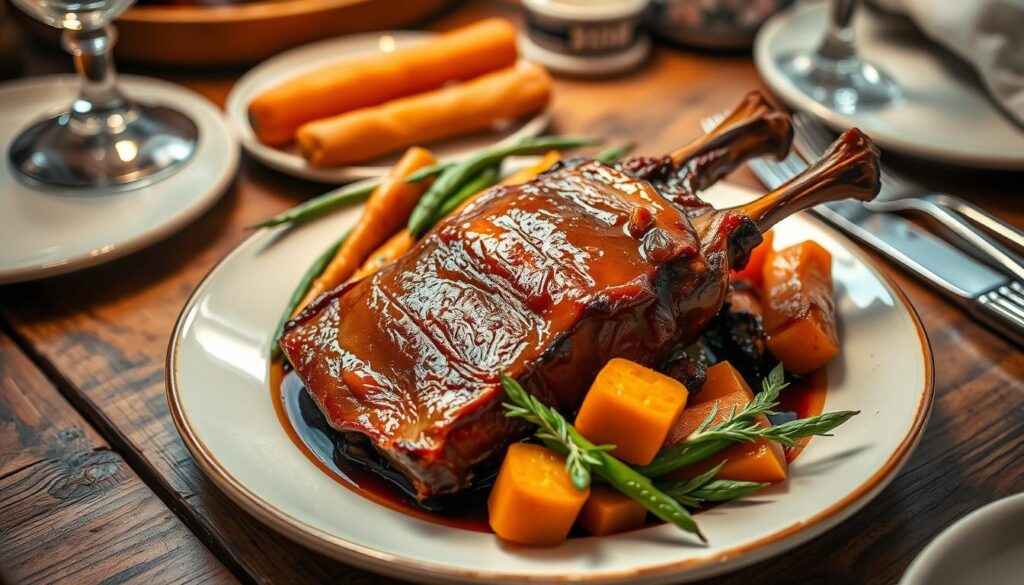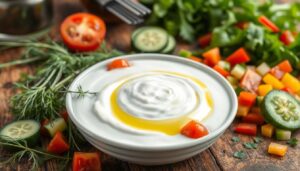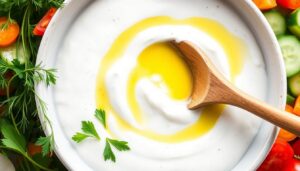The smell of duck legs cooking slowly fills the kitchen. It takes you back to a charming French village. Duck Duck confit has been loved for centuries, showing how the French turn simple things into something special. But did you know you can make this French classic at home easily?
This guide, based on traditional French culinary expertise, will take you through duck confit’s history and cooking techniques. Used by professional chefs and home cooks alike, the confit method ensures tender, flavorful meat with a crispy skin. With expert-backed tips and food safety recommendations, you’ll learn how to make perfect duck confit with confidence. Whether you’re an experienced cook or just starting, this trusted guide will help you master this timeless dish.
Table of Contents
Understanding Duck Confit: A French Culinary Heritage
Explore the rich history of duck duck confit, a key part of French cooking. This dish comes from old ways of keeping food fresh, where duck legs were cooked in their own fat. Now, duck confit is a favorite dish among food lovers.
Origins and Traditional Preparation Methods
The story of duck confit starts in Gascony, southwestern France. Farmers there found a way to use their duck resources fully. They salted the duck legs and cooked them in their own fat until they were very tender. This method not only keeps the meat fresh but also makes it very flavorful.
Why Duck Confit Remains a Beloved Dish
- The unique, melt-in-your-mouth texture of the duck meat, which is both tender and succulent.
- The crisp, savory skin that provides a delightful contrast to the rich interior.
- The deep, complex flavors developed through the slow-cooking process, which enhances the natural taste of the duck.
- The versatility of duck confit, which can be incorporated into a wide range of dishes, from hearty stews to elegant appetizers.
Today, duck confit is a favorite in French cooking. It’s loved for its amazing taste, texture, and history. Its lasting popularity shows how much people love this classic dish.
Essential Ingredients for Perfect Duck Duck Confit
Making delicious duck leg confit requires high-quality ingredients and time-tested techniques. At its core, this classic French dish relies on premium duck legs, ensuring a rich, flavorful result. The secret to perfectly cooked duck legs, as practiced by expert chefs, lies in a precise balance of salt, aromatic herbs like thyme and bay leaves, and rendered duck fat. By following traditional confit methods and proper food safety guidelines, you can achieve restaurant-quality results in your own kitchen.
Start by getting fresh, high-quality duck legs. They should be plump with a lot of fat. This fat will melt and baste the meat as it cooks. Next, use coarse sea salt to cure the duck legs. This step draws out moisture and boosts flavor.
- Fresh, high-quality duck legs
- Coarse sea salt
- Aromatic herbs such as thyme, rosemary, and bay leaves
- Rendered duck fat
Choose aromatic herbs like thyme, rosemary, and bay leaves. They add a rich flavor to the duck. The rendered duck fat is key. It cooks the duck legs gently, making them tender and delicious.
“The secret to the best duck leg confit lies in the quality of the ingredients and the patience of the cook.”
With these ingredients, you’re set to make a duck duck confit that’s a true French culinary delight.
Selecting the Best Duck Legs for Confit
Choosing the right duck legs is key to making perfect duck confit. The quality of the meat greatly affects the taste and texture of the dish. Whether you pick fresh or frozen duck legs, knowing what to look for is important.
Fresh vs. Frozen Duck Legs
Both fresh and frozen duck legs can yield excellent results for confit. Fresh duck legs allow for immediate inspection of quality, ensuring optimal texture and flavor. Frozen duck legs, when properly thawed, offer a convenient option for meal planning and can be just as flavorful. Professional chefs recommend sourcing high-quality, ethically raised duck to enhance the authenticity and taste of your confit.
Quality Indicators to Look For
- Size: Choose duck legs that are big and meaty for more flavor and meat.
- Color: The skin should be bright, golden-yellow, showing the duck was healthy and well-fed.
- Texture: The legs should feel firm and juicy, with little extra fat or tough parts.
- Freshness: Fresh legs should smell clean and fresh, with no signs of spoilage.
By picking the best duck legs, you’re on your way to a delicious duck confit. Embrace the French tradition of this dish and let your ingredients make every bite special.
The Art of Duck Fat Selection and Preparation
Creating a delicious duck confit starts with the right duck fat. This fat gives the meat its rich flavor and soft texture. Knowing how to pick and prepare duck fat is key to a great duck confit recipe.
Varieties of Duck Fat
Duck fat can vary in taste and quality. The breed of duck, its diet, and how it’s rendered all affect it. Here are some common types:
- Farm-raised duck fat: Mild and versatile, perfect for confit.
- Wild duck fat: Has a stronger, gamier taste, loved by those who know.
- Rendered duck fat: Pure and clean, made by simmering and straining.
Rendering Your Own Duck Fat
Rendering your own duck fat at home is a great idea. It lets you control the quality and keep it clean. Here’s how:
- Start with duck fat trimmings or skin.
- Put the fat in a heavy pot or slow cooker. Cook it slowly to separate the fat from solids.
- Strain the fat through a fine-mesh sieve or cheesecloth. Throw away the solids.
- Keep the duck fat in an airtight container in the fridge for up to 3 months.
| Duck Fat Quality | Flavor Profile | Best Uses |
|---|---|---|
| Farm-raised | Mild and versatile | General cooking, duck duck confit |
| Wild | Intense, gamy | Searing, roasting, confit |
| Rendered | Pure, concentrated flavor | Sautéing, duck confit, baking |
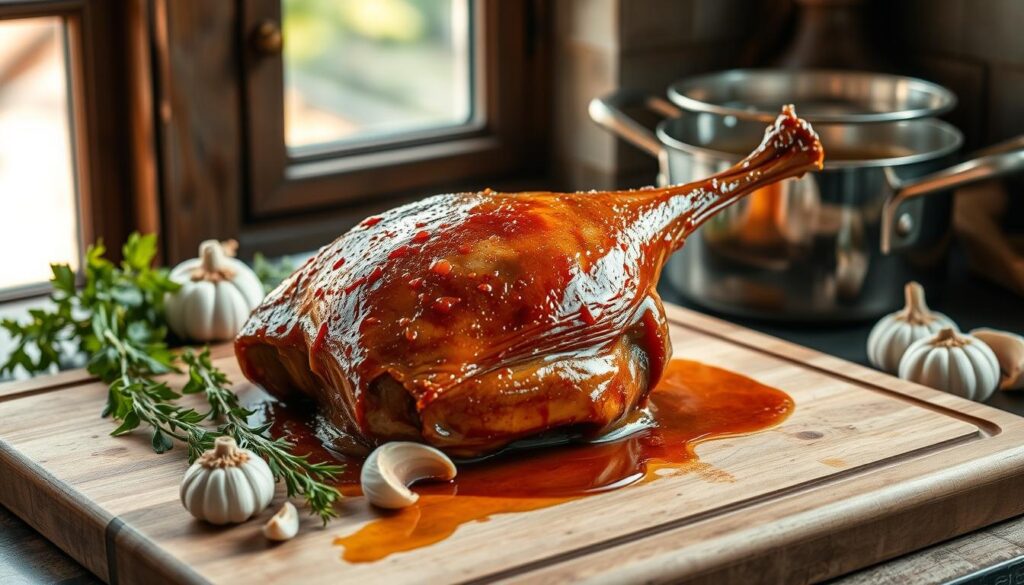
Mastering duck fat selection and preparation is key for a perfect duck duck confit. By choosing the right type and rendering your own fat, you’ll make a dish that honors French cuisine.
Mastering the Duck Leg Curing Process
Creating the perfect duck duck confit starts with curing. Knowing how to mix salt and herbs is key. Also, understanding the right curing time is important. This is what makes duck confit so special.
Salt and Herb Combinations
The salt and herb mix is the heart of a great duck confit. A classic mix includes kosher salt, black pepper, and thyme. But, you can also try other herbs and spices to make it your own.
Adding garlic, bay leaves, or juniper berries can enhance the flavor. These ingredients add depth to the duck’s natural taste.
Optimal Curing Times
The curing time is vital for the duck confit’s texture and taste. Cure the duck legs for 12-24 hours in the fridge. Turn them a few times to season evenly.
The longer you cure, the stronger the flavor. But, be careful not to cure too long. This can make the duck too salty.
Mastering duck leg curing is all about experimenting. Find the perfect mix of salt, herbs, and curing time for you. With practice, you’ll make a delicious duck confit.
Equipment Needed for Duck Duck Confit
To make delicious duck leg confit at home, you need the right tools. The right equipment makes the process smooth and successful. Let’s look at the key items for this classic French dish.
The Vessel: A Heavy-Bottomed Pot
A heavy-bottomed pot or Dutch oven is the base for your confit adventure. It spreads heat evenly, avoiding hot spots that could burn your duck legs. Choose a pot with a tight lid to keep moisture and flavor in during cooking.
Temperature Control: A Reliable Thermometer
When making duck leg confit, precision is key. A good food thermometer helps you keep an eye on the temperature. This ensures your duck legs are tender and cooked just right.
Storage Solutions: Airtight Containers
After cooking, you’ll need containers to store your duck leg confit. Choose airtight, heavy containers like glass or stainless steel. They keep the duck fat in and air out.
| Essential Equipment | Purpose |
|---|---|
| Heavy-Bottomed Pot or Dutch Oven | Evenly distribute heat during the long, slow cooking process |
| Food Thermometer | Precisely monitor the cooking temperature to achieve tender, perfectly cooked duck leg confit |
| Airtight Storage Containers | Preserve the rich flavor and texture of the duck leg confit for later enjoyment |
With these tools, you’re ready to make tasty duck leg confit at home. Dive into the rich history of this French dish and show off your cooking skills.
Step-by-Step Cooking Temperature Guide
To make perfect duck confit, precise temperature control is essential. Cooking at a low, consistent heat—around 190°F (88°C)—ensures the duck legs become tender while maintaining their rich flavor. Using a thermometer helps achieve the ideal slow-cooking environment, preventing overcooking or drying out. This method, backed by culinary experts, ensures your duck confit rivals the best French bistros.
Initial Heat Settings
Start by heating your oven to 300°F (150°C). This gentle heat helps melt the duck fat and cooks the meat slowly. It makes the flavors blend and the meat tender.
Maintaining Perfect Temperature
- When the oven is ready, gently put the duck legs into the hot duck fat. Make sure they’re fully covered.
- Then, adjust the oven to keep it at 250°F (120°C) for the whole cooking time. This low heat cooks the duck confit evenly and prevents it from burning.
- Use an oven-safe thermometer to check the temperature. Make small changes as needed to stay in the perfect range.
By following this guide, you’ll get better at making duck duck confit recipe. Your how to cook duck legs will be tender and full of flavor. It will impress your guests and satisfy your love for this French dish.
Time Management: Planning Your Confit Schedule
Making duck duck confit might seem like a lot of work. But with good planning, you can fit it into your busy schedule. The secret is to know each step and plan the time for it.
The first step is curing the duck legs. This takes 12 to 36 hours, depending on how salty you like it. Keep the legs in the fridge during this time. It lets the salt and herbs soak into the meat, giving it that special duck duck confit taste.
- Curing: 12-36 hours
- Cooking: 2-4 hours
- Resting: 2-4 hours
After curing, it’s time to cook the duck legs. This takes 2 to 4 hours, depending on the size and the heat. Cooking in duck fat makes the meat soft and delicious.
After cooking, let the duck confit rest for 2 to 4 hours. This step is important. It lets the flavors mix and the fat to set. This makes the skin crispy when you serve it.
Plan ahead and you can make this simple duck legs recipe part of your meal prep. A little planning lets you enjoy the rich taste of duck duck confit whenever you want.
Signs of Perfectly Cooked Duck Legs
Getting the perfect texture and flavor in your duck leg confit is every home chef’s dream. But how do you know when it’s just right? By knowing the visual and tactile signs, you can make sure your confit is always perfect.
Visual Indicators
The skin of a perfectly cooked duck leg confit should be a deep, golden brown. It should look almost mahogany. The meat should be so tender it falls off the bone easily. The fat around the meat should be clear and rich, showing that all the connective tissues have broken down.
Texture Testing Methods
To check if your duck legs are tender, just stick a fork into the thickest part of the meat. If it slides in smoothly and the meat feels soft, it’s ready. You can also press the leg with your finger. If it feels soft and velvety, with no resistance, it’s cooked just right.
| Visual Indicators | Texture Testing |
|---|---|
| Deep, golden-brown skin | Fork slides in easily |
| Meat falling off the bone | Meat yields to gentle pressure |
| Translucent, rich fat | Soft, velvety texture |
By watching for these visual and tactile signs, you can make sure your duck leg confit is cooked to perfection. This ensures the tender, flavorful meat that makes this French dish so famous.
Storage and Preservation Techniques
Storing and preserving your duck confit right is key to keeping its great taste and texture. Whether you’re enjoying a duck-duck confit recipe or the classic French dish, these tips will help keep your confit delicious.
Traditional Confit Storage
The old way to store duck confit is to soak the cooked legs in duck fat. This seals them in, keeping the meat good for months. Just put the duck legs in a tight container, cover them with fat, and keep it cool and dark, like the fridge or cellar.
Modern Preservation Alternatives
If you want easier storage, try vacuum-sealing or canning your duck confit. Vacuum-sealing keeps it fresh and stops it from getting old, letting you freeze it for up to six months. Canning makes it last even longer, up to a year.
| Storage Method | Shelf Life | Ideal Storage Conditions |
|---|---|---|
| Traditional Confit in Fat | 3-6 months | Refrigerator or cool cellar |
| Vacuum-sealed | Up to 6 months | Freezer |
| Canned | Up to 1 year | Pantry |
Whichever method you pick, watch your duck confit for any bad signs like color changes or smells. With the right care, you can enjoy this French favorite for months.
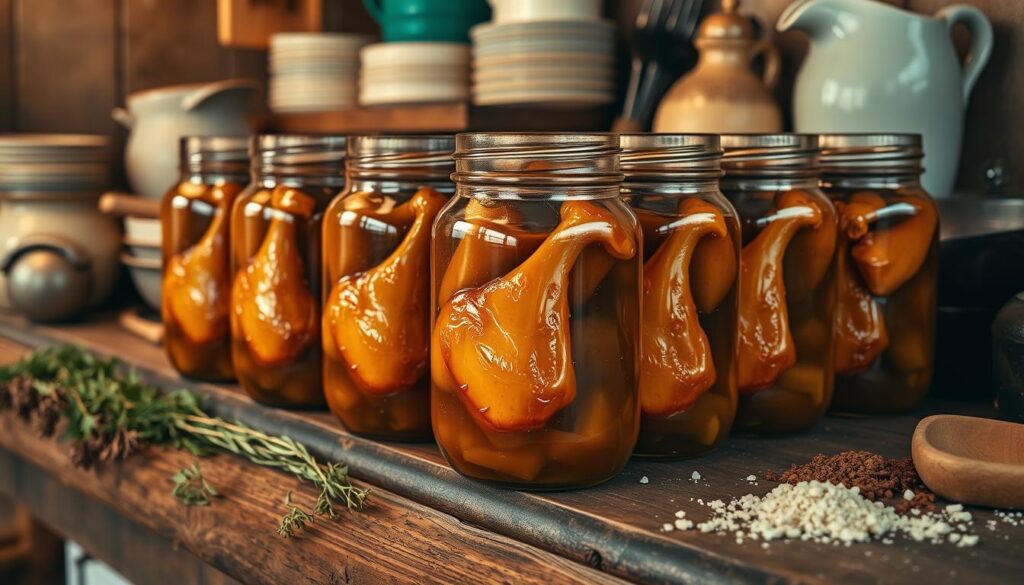
Reheating Your Duck Confit
Perfecting duck confit goes beyond the first cooking. Reheating it right is key to getting that crispy skin and juicy meat. Whether it’s a main dish or part of another meal, reheating it well brings out the best of this French classic.
Optimal Methods for Crispy Skin
To get crispy skin on your duck confit, try these methods:
- Oven Reheating: Heat your oven to 400°F (200°C). Put the duck legs skin-side up on a baking sheet. Heat for 15-20 minutes until the skin is golden and crunchy.
- Stovetop Crisping: Heat a skillet over medium-high. Add the duck legs, skin-side down. Cook for 5-7 minutes until the skin is crisp. Then, flip and cook for another 3-5 minutes.
- Air Fryer Magic: Set your air fryer to 400°F (200°C). Cook the duck legs for 12-15 minutes, flipping halfway. This will make the skin perfectly crisp.
Temperature and Timing Guidelines
Follow these guidelines for perfect reheating:
| Reheating Method | Temperature | Timing |
|---|---|---|
| Oven | 400°F (200°C) | 15-20 minutes |
| Stovetop | Medium-high heat | 5-7 minutes (skin-side down), 3-5 minutes (flipped) |
| Air Fryer | 400°F (200°C) | 12-15 minutes, flipping halfway |
The goal is to heat the duck confit through while crisping the skin. Adjust the timing and temperature as needed to get your desired results.
Classic Side Dishes for Duck Confit
When you serve duck confit, it’s key to pair it with side dishes that make the meal better. You can choose from classic French dishes or try new ideas. Here are some tasty options for your duck confit recipe or simple duck legs recipe.
Crisp Potatoes
No duck confit meal is complete without crispy potatoes. You can go for pommes de terre sarladaises (potatoes cooked in duck fat) or pommes frites (french fries). Both are great with the rich, tender duck.
Sautéed Greens
Balance the duck confit with sautéed greens like spinach, kale, or Swiss chard. Their fresh flavors and colors make a nice contrast.
Ratatouille
Ratatouille, a Provençal vegetable stew, is a great match for duck confit. It’s full of eggplant, zucchini, tomatoes, and herbs. The bright flavors go well with the duck.
Roasted Garlic Mashed Potatoes
Roasted garlic mashed potatoes are creamy and comforting. They offer a nice contrast to the bold duck confit.
Caramelized Onions
Caramelized onions add a sweet, jammy flavor to your dish. They’re great as a topping or side to balance the duck’s richness.
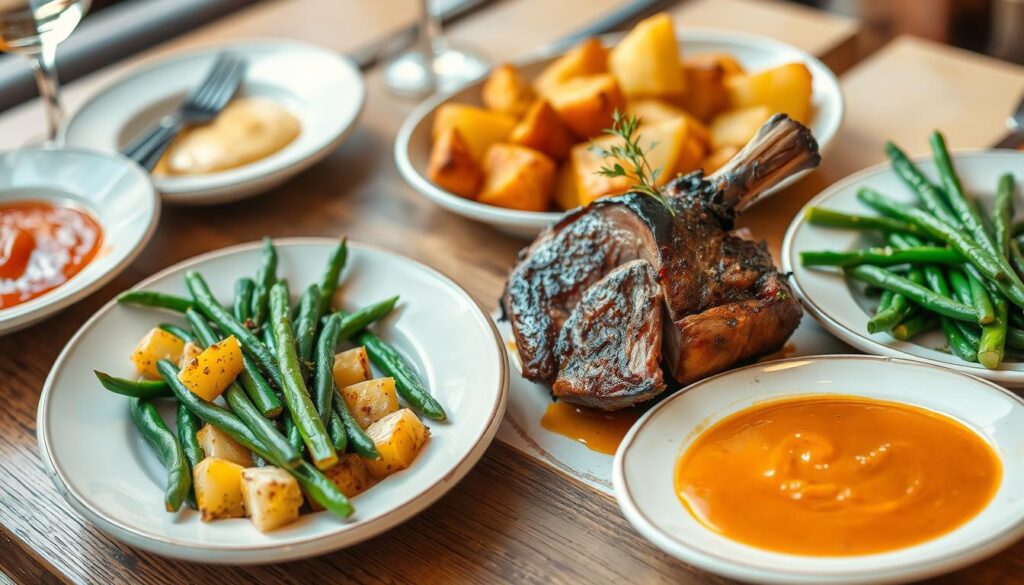
“Duck confit is a true delight, and the right side dishes can elevate it to an unforgettable culinary experience.”
Conclusion
Exploring duck duck confit has shown us its rich history and tasty flavors. Now, you can make this classic French dish at home. Learn to cook confit and enjoy tender duck legs that feel like a trip to Gascony.
For perfect duck duck confit, choose the best duck legs. Use the right duck fat and cure and cook the meat slowly. This way, you’ll get the same delicious texture and flavors that people love.
Feel free to add your own twist to this traditional recipe. Try it with fresh veggies, herbs, or a crisp salad. Mastering this French technique is rewarding. Share your duck duck confit with loved ones and enjoy the joy of cooking. Reviewed by Koujil Amine, founder of YummyWhirl, and generated by Emma Chef.
